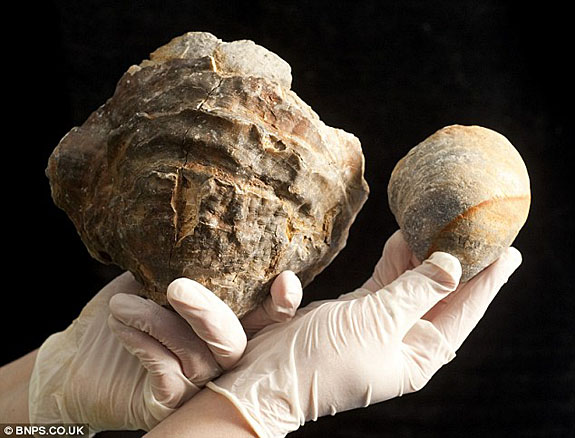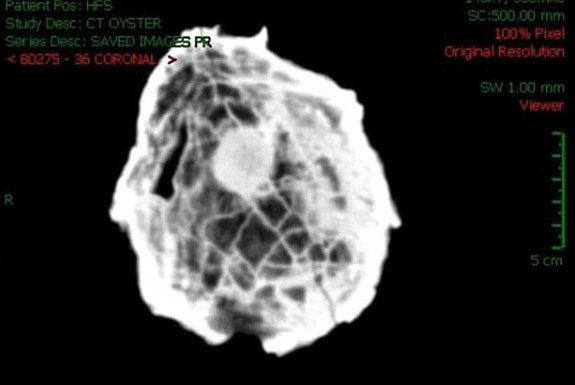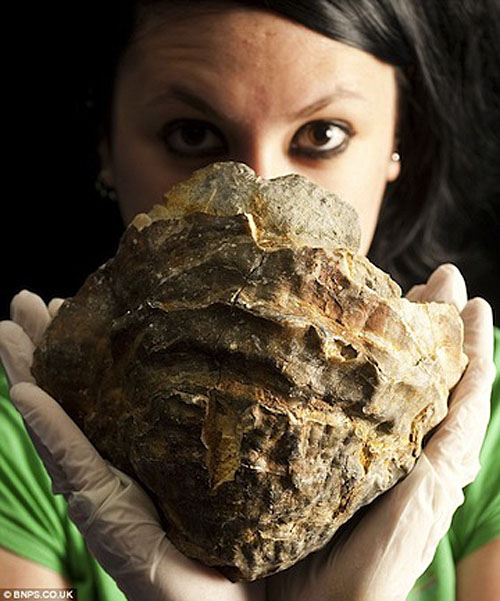Mammoth 145-Million-Year-Old Oyster Fossil May Contain Golf Ball-Sized Natural Pearl
By: Kelly York
Today we’re honoring June’s official birthstone – the lovely pearl — by bringing you a glimpse of a rare ancient fossil 10 times the size of an average oyster that is likely concealing an extraordinary treasure – a natural pearl the size of a golf ball.
 The seven-inch fossilized oyster, which is estimated to be 145 million years old, was scanned with sophisticated MRI equipment that revealed the presence of a round, smooth object that could be a giant pearl.
The seven-inch fossilized oyster, which is estimated to be 145 million years old, was scanned with sophisticated MRI equipment that revealed the presence of a round, smooth object that could be a giant pearl.
 This mammoth oyster reportedly turned up in the Solent, a strait separating mainland England from the Isle of Wight. The rare specimen is currently housed at the Blue Reef Aquarium in Portsmouth, UK, where it is seen only at lectures.
Lindsay Holloway of the Aquarium told The Daily Mail: “It was discovered in the nets of a fishing boat which was dredging here. When the fishermen came back to port they thought it was [live], but when they picked it up, cleaned it, and had a closer look they could tell it was a fossil. It had completely turned to stone.”
This mammoth oyster reportedly turned up in the Solent, a strait separating mainland England from the Isle of Wight. The rare specimen is currently housed at the Blue Reef Aquarium in Portsmouth, UK, where it is seen only at lectures.
Lindsay Holloway of the Aquarium told The Daily Mail: “It was discovered in the nets of a fishing boat which was dredging here. When the fishermen came back to port they thought it was [live], but when they picked it up, cleaned it, and had a closer look they could tell it was a fossil. It had completely turned to stone.”
 Aquarist Jenna MacFarlane from the Blue Reef Aquarium holds the gigantic oyster that could contain a huge natural pearl.
Holloway explained that oysters could be aged by the annual growth rings on their shells. “We have counted more than 200 rings on this oyster, making it an extremely long-lived individual,” Holloway said. “It’s obviously a million-to-one chance that it would contain anything, but if you were to go purely on the dimensions of the shell then you’d be looking at a golf ball-sized pearl.”
If the object inside were removed and identified as a pearl, it could be priceless – but it would mean destroying the rare fossil, which is an unacceptable trade-off for Holloway and her team.
Natural pearls are formed inside the shells of bivalve mollusks as a defense mechanism against an irritant. The mollusk secretes layers of nacre (calcium carbonate) to seal off the irritation. This secretion process is repeated many times, producing a iridescent pearl. Natural pearls come in various shapes, with perfectly round pearls being the most rare.
Aquarist Jenna MacFarlane from the Blue Reef Aquarium holds the gigantic oyster that could contain a huge natural pearl.
Holloway explained that oysters could be aged by the annual growth rings on their shells. “We have counted more than 200 rings on this oyster, making it an extremely long-lived individual,” Holloway said. “It’s obviously a million-to-one chance that it would contain anything, but if you were to go purely on the dimensions of the shell then you’d be looking at a golf ball-sized pearl.”
If the object inside were removed and identified as a pearl, it could be priceless – but it would mean destroying the rare fossil, which is an unacceptable trade-off for Holloway and her team.
Natural pearls are formed inside the shells of bivalve mollusks as a defense mechanism against an irritant. The mollusk secretes layers of nacre (calcium carbonate) to seal off the irritation. This secretion process is repeated many times, producing a iridescent pearl. Natural pearls come in various shapes, with perfectly round pearls being the most rare.
 Visit Ben David Jewelers on Facebook
Visit BenDavidJewelers.com
Find us on Pinterest.
Visit Ben David Jewelers on Facebook
Visit BenDavidJewelers.com
Find us on Pinterest.
 The seven-inch fossilized oyster, which is estimated to be 145 million years old, was scanned with sophisticated MRI equipment that revealed the presence of a round, smooth object that could be a giant pearl.
The seven-inch fossilized oyster, which is estimated to be 145 million years old, was scanned with sophisticated MRI equipment that revealed the presence of a round, smooth object that could be a giant pearl.
 This mammoth oyster reportedly turned up in the Solent, a strait separating mainland England from the Isle of Wight. The rare specimen is currently housed at the Blue Reef Aquarium in Portsmouth, UK, where it is seen only at lectures.
Lindsay Holloway of the Aquarium told The Daily Mail: “It was discovered in the nets of a fishing boat which was dredging here. When the fishermen came back to port they thought it was [live], but when they picked it up, cleaned it, and had a closer look they could tell it was a fossil. It had completely turned to stone.”
This mammoth oyster reportedly turned up in the Solent, a strait separating mainland England from the Isle of Wight. The rare specimen is currently housed at the Blue Reef Aquarium in Portsmouth, UK, where it is seen only at lectures.
Lindsay Holloway of the Aquarium told The Daily Mail: “It was discovered in the nets of a fishing boat which was dredging here. When the fishermen came back to port they thought it was [live], but when they picked it up, cleaned it, and had a closer look they could tell it was a fossil. It had completely turned to stone.”
 Aquarist Jenna MacFarlane from the Blue Reef Aquarium holds the gigantic oyster that could contain a huge natural pearl.
Holloway explained that oysters could be aged by the annual growth rings on their shells. “We have counted more than 200 rings on this oyster, making it an extremely long-lived individual,” Holloway said. “It’s obviously a million-to-one chance that it would contain anything, but if you were to go purely on the dimensions of the shell then you’d be looking at a golf ball-sized pearl.”
If the object inside were removed and identified as a pearl, it could be priceless – but it would mean destroying the rare fossil, which is an unacceptable trade-off for Holloway and her team.
Natural pearls are formed inside the shells of bivalve mollusks as a defense mechanism against an irritant. The mollusk secretes layers of nacre (calcium carbonate) to seal off the irritation. This secretion process is repeated many times, producing a iridescent pearl. Natural pearls come in various shapes, with perfectly round pearls being the most rare.
Aquarist Jenna MacFarlane from the Blue Reef Aquarium holds the gigantic oyster that could contain a huge natural pearl.
Holloway explained that oysters could be aged by the annual growth rings on their shells. “We have counted more than 200 rings on this oyster, making it an extremely long-lived individual,” Holloway said. “It’s obviously a million-to-one chance that it would contain anything, but if you were to go purely on the dimensions of the shell then you’d be looking at a golf ball-sized pearl.”
If the object inside were removed and identified as a pearl, it could be priceless – but it would mean destroying the rare fossil, which is an unacceptable trade-off for Holloway and her team.
Natural pearls are formed inside the shells of bivalve mollusks as a defense mechanism against an irritant. The mollusk secretes layers of nacre (calcium carbonate) to seal off the irritation. This secretion process is repeated many times, producing a iridescent pearl. Natural pearls come in various shapes, with perfectly round pearls being the most rare.
